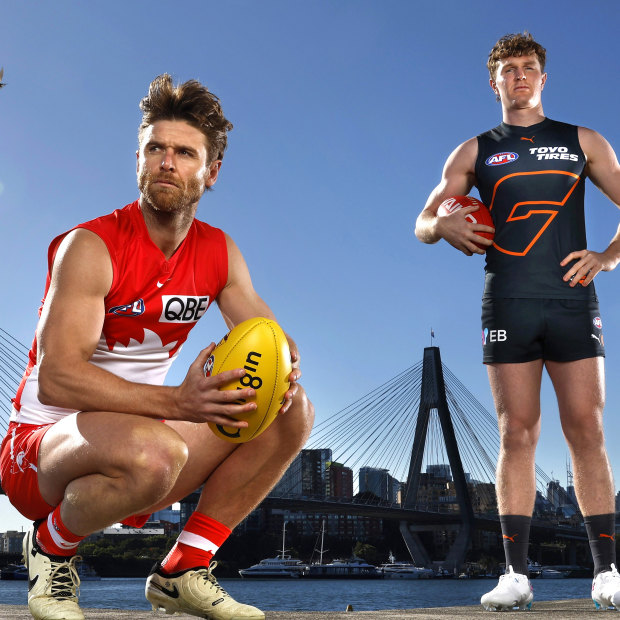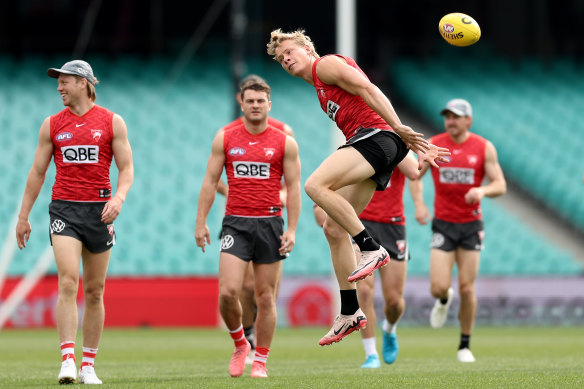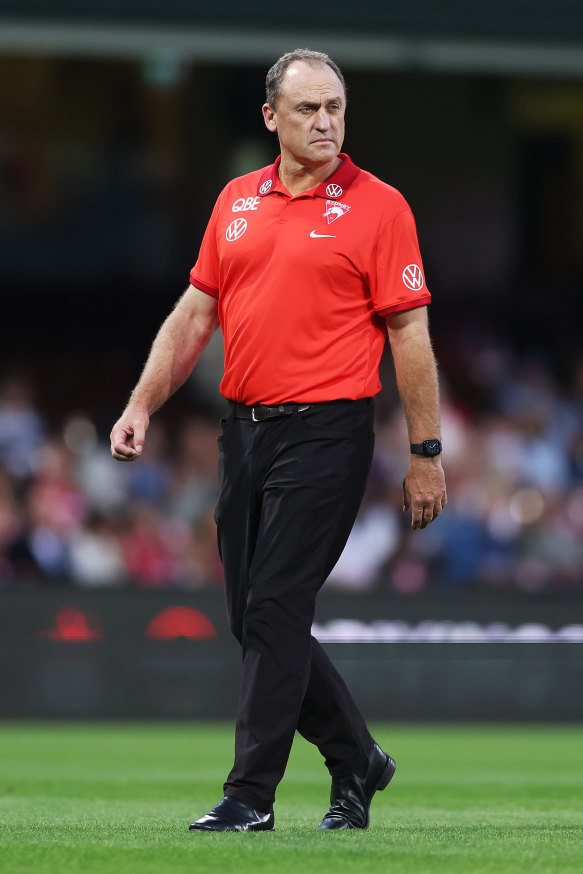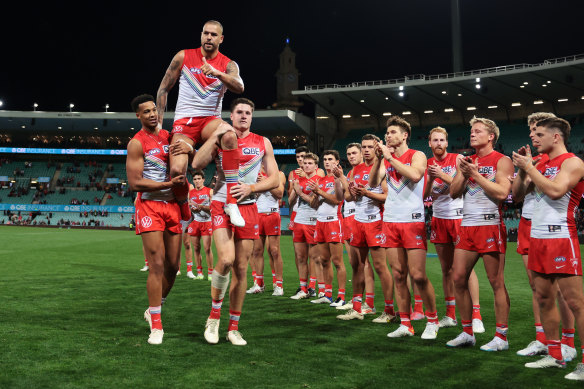This was published 10 months ago
Squeaky-clean Swans and the Giants of self-promotion
For decades, Sydney’s brand has been akin to a manicured lawn lined with immaculately pruned shrubs. For those inclined towards the loose-unit vibes at GWS, the compulsion is to snip off a few branches.
By Emma Kemp and Vince Rugari

The Swans’ Dane Rampe and Tom Green of the Giants take an epic rivalry to the next level in Saturday’s qualifying final.Credit: Phil Hillyard
You could practically hear the collective gasp emanate from Swans headquarters in August when John Longmire had a crack at Craig McRae.
Any journalist who has ever attended one of ‘Horse’s’ weekly media stand-ups or post-match press conferences in his 13-odd years at the helm will know this head coach is an expert in playing a straight bat to almost every question that comes his way. So when he finally bit at the perceived irony of a Collingwood coach complaining about home-ground advantage, it was very unHorse-like indeed.
Even in the midst of his “extraordinary admission” comments, the affable demeanour remained. And by the time the next interview rolled around, he had completely reverted to type. Saying a lot without saying much at all. Always cheerful. Always complimentary of the opposition. Never stirring the pot.
Now it is the first week of finals and, though you can feel it in the air and see it in the ticket sales (well and truly sold out), you wouldn’t know it from Sydney’s playing contingent. Just like their coach, who is exceptional at both his job and his inexplicit brand of messaging, several squad members have cycled through a series of nice and polite and perfectly pleasant interviews – all without saying a negative word about Greater Western Sydney.

Isaac Heeney and the Swans at training this week.Credit: Getty Images
Even Isaac Heeney, the subject of some pretty significant Giants mimicry back in July (read: the Toby Greene video feud), would not be drawn into uttering anything resembling a barb before his club’s Sydney derby qualifying final at the SCG on Saturday afternoon. Not even now the Swans are minor premiers and Sam Taylor’s “chirpy” and “smug” comments before April’s first regular-season derby may not have aged so well. “We let them be them, and we’ll focus on what we can do to impact the game,” Heeney said on Monday. “Really, the media is what they want to do to try and get engagement, and we just don’t buy into that.”
He was referring to the famous – perhaps infamous – social media presence: a meme machine across X, Instagram and TikTok reflecting efforts by the AFL’s youngest club to generate more buzz in a tough geographical landscape. It conjures social media posts on the Giants’ official accounts that roast their own players for crooked parking and tribunal appearances. They are the masterful work of Jacob Gaynor, the club’s content king who is developing such a name for himself he has been profiled by GQ.
But wait, weren’t we trying to talk to the Swans about the Swans? How has Heeney mastered such skills in deflection? Does Longmire and Sydney’s own media team keep the players on the straight and narrow in terms of what they say in public? “Yeah, they do to a certain degree,” Heeney said as he stood next to the club’s amused head of marketing and communications. “But at the same time I think the boys are pretty switched on and understand the power of words, and where to go and where not to go.”

John Longmire: affable and unflappable.Credit: Getty
The keep-it-clean attitude is a fascinating subplot to what should, based on events this year, be one of the more heated finals fixtures regardless of how the rest of September plays out. And yet the Swans appear intent on ensuring they are not nearly as “good on the tongue” as Heeney says Greene and Gaynor are.
For decades – possibly dating as far back as the flamboyant days of the late Dr Geoffrey Edelsten – Sydney’s brand has been akin to a manicured lawn lined with immaculately pruned shrubs. For those more inclined towards the loose-unit vibes at GWS, the compulsion is to snip off a few branches, maybe even have your dog defecate in the yard, just to give it some of the flaws that humans so love in their sports stars. Just to turn the vanilla into literally any other flavour.
But perhaps this is overlooking some pretty clear evidence that rusted-on Swans fans seem to like it just fine this way. It is, after all, born from The Bloods culture: the defining characteristic of the modern Sydney Swans based on player-led communication that flew in the face of the old-school concept of top-down demands. A player-driven initiative cemented into its DNA by the 2005 premiership and Paul Roos’ unofficial no-dickheads policy.
According to Swans premiership player Luke Ablett, the key ingredient at a football club is “not just the statistical measurements, but the character traits that you aspire to”. “That might be training standards, recovery standards or what you go and do on a Saturday night,” Ablett wrote in 2014. “You establish those values and desired characteristics and decide how you want [to] see yourself as a group.”
‘We’re not trying to pick fights with anyone or score points.’
Andrew Pridham, Swans CEO
But Ablett also acknowledged the power of on-field success in reinforcing those values. Which might mean that boring off the field does not matter one iota if you are exciting on it. And the Swans are, irrefutably, exciting on it. They have missed the finals only three times in more than 20 years, to the point a September campaign is a mere formality for most supporters.
“We’ve had a lot of consistency with the club, so we’ve been able to maintain a consistent culture,” says Swans chairman Andrew Pridham. “It’s football first, so our focus is on winning football games, and I think we never lose sight of that. We try not to get distracted by other things, which sometimes clubs do. And culturally we do try and set standards. We’re not perfect, we just try and get better every day, and when things don’t go right to focus on why and try and fix them.”
Roos and then Longmire have somehow overseen a constantly evolving roster while also avoiding the boom-and-bust periods endured by many a rival. Josh Kennedy, a former Swans captain and 2012 premiership player, believes this consistency is seared into the club’s identity partly through a desire to be recognised by traditional AFL heartlands south-west of the Barassi Line – an imaginary divide between NSW and Victoria that delineates between Australian rules and rugby league domination. “Being there before the Giants got there, and away from the limelight, the club and players haven’t traditionally got as much recognition as some of the bigger Melbourne clubs,” Kennedy says. “So to prove a point, you’ve just got to continue to win and continue to be up there. Play well and let that do the talking.”
Regardless, Pridham insists the squeaky-clean persona is not a “deliberate strategy” but an organic culture. “We’re not trying to pick fights with anyone or score points,” he says. “We respect the game, we respect the other clubs and people involved in it, and we just want to be the best versions of us that we can be – as boring as it might sound. There’s a lot of the superstars who do their talking on the field rather than off. You’ve seen that recently with [Richmond star] Dustin Martin’s unwillingness to be interviewed. At the end of the day, most fans want to love the players and, the better the player, the more they tend to love and want to be able to respect them.”

Lance Franklin finished his career as a much-loved enigma.Credit: Getty
This last part is in response to a question about Lance Franklin, the defining figure of footy in NSW despite being famously media-shy and arguably not fully known by his fans right up to his retirement last year. Former Swans ruckman Callum Sinclair puts this partly down to individual personalities, and cites Geelong’s Patrick Dangerfield as a natural “AFL media performer”, in contrast to the majority of his contemporaries to whom this type of interaction does not come naturally. But he also referenced the media’s responsibility to ask questions which elicit answers outside the rote-learned norm.
“If you went to a press conference and asked, ‘How do you feel about this weekend’s game?’ What answer do you think you’re going to get?” Sinclair says. “Of course the players will sit there and say, ‘Yeah, excited about playing finals football. It’s what we live for, September action. We respect the other team’.”
Sinclair believes the Giants are adopting the jokers-from-out-west persona to gain traction in “a very challenging market” dominated by rugby league and soccer. “So to have a presence and a defined brand that stands out compared to a lot of other clubs in the league,” he says. “They’ve got that cheeky nature about them, of a playing group that’s quite fun and relaxed … I guess they’re probably just trying to really contribute to the rivalry between both clubs in the code up here, and they tend to poke and prod where they can and get a bit of a reaction.”
Gaynor was employed by the Giants in 2021 to do just that, and his pithy one-liners and super-specific takedowns via the club’s official social media accounts are inspired by the American sporting clubs and designed to attract eyeballs and grow metrics. Between January and April, the Giants’ collective social media following grew by more than 10,000 followers and now sits a little north of 300,000. While that’s well shy of Sydney’s almost 500,000 followers, the rapid upward trajectory of a less-established club indicates the strategy is clearly working.
Every one of Gaynor’s posts is a tiny piece of micro-branding that contributes to the outside world’s view of the club (as quite possibly the Bart Simpson of the AFL), and he does his work with enthusiastic support from chief executive David Matthews, president Tony Shepherd and head coach Adam Kingsley.
“Last year, especially towards the end of the finals run and things, he [Kingsley] would come up to me and ask what this week’s meme was,” Gaynor says. “He was pretty eager, and found it quite funny. I think his kids keep him updated, and he’s got a secret little Instagram account that I don’t think anyone knows he has.”
But the trolling has not always been appreciated across the other side of town. Greene’s video in July, which set out to parody the heavily ridiculed, very earnest video recorded by Heeney after a suspension ruled him out of Brownlow Medal contention got under the skin of Swans chief executive Tom Harley enough to call it “pretty low-brow”.
Gaynor felt as if he was being told off by the school principal. “My dad’s a principal, so it felt very similar – the whole ‘we’re not mad, just very disappointed’ approach,” he says. “But I actually grew up a mad Swans fan, so to have Tom Harley and John Longmire and Paul Roos and the likes come out and publicly say they don’t love what you’re doing, that’s pretty funny.”
Whatever it is, the clearly contrasting identities are working in tandem to grow the game in NSW, where membership numbers across both clubs are constantly climbing. “You wouldn’t want the clubs to be similar,” Gaynor says. “What the Swans do might work for them, but it doesn’t necessarily work for us. And whilst we’re in the same state, we’re in completely different markets and trying to grow the game in different ways.”
Keep up to date with the best AFL coverage in the country. Sign up for the Real Footy newsletter.